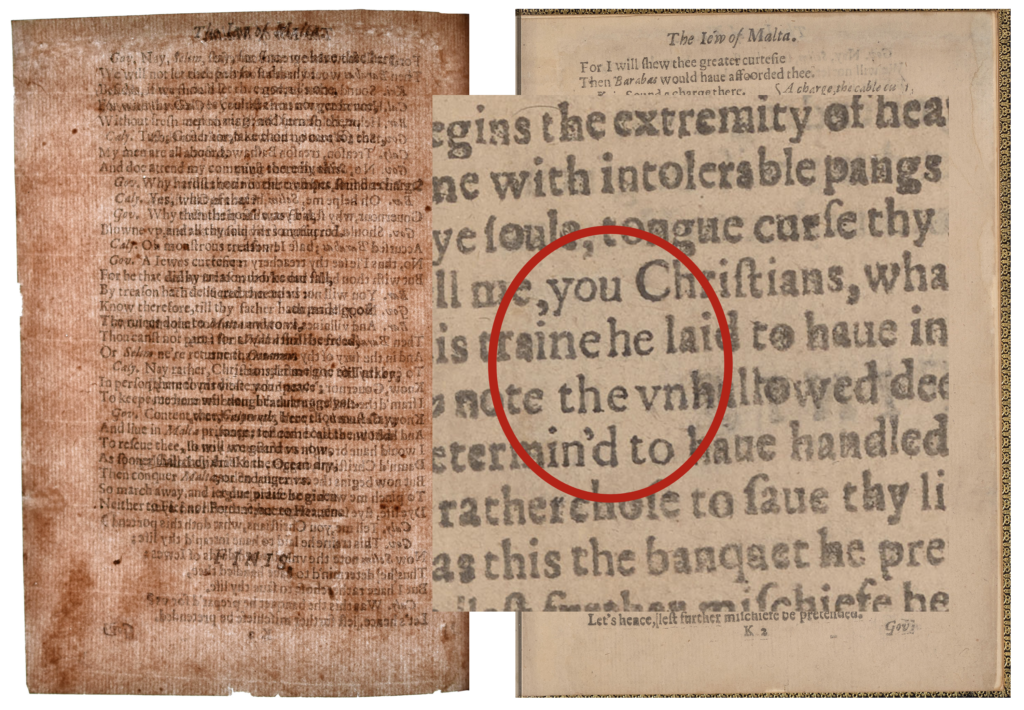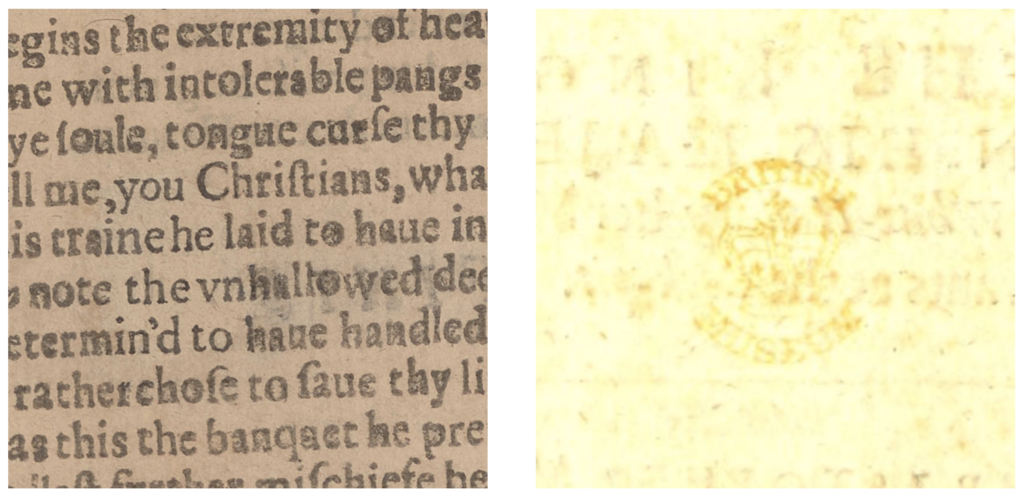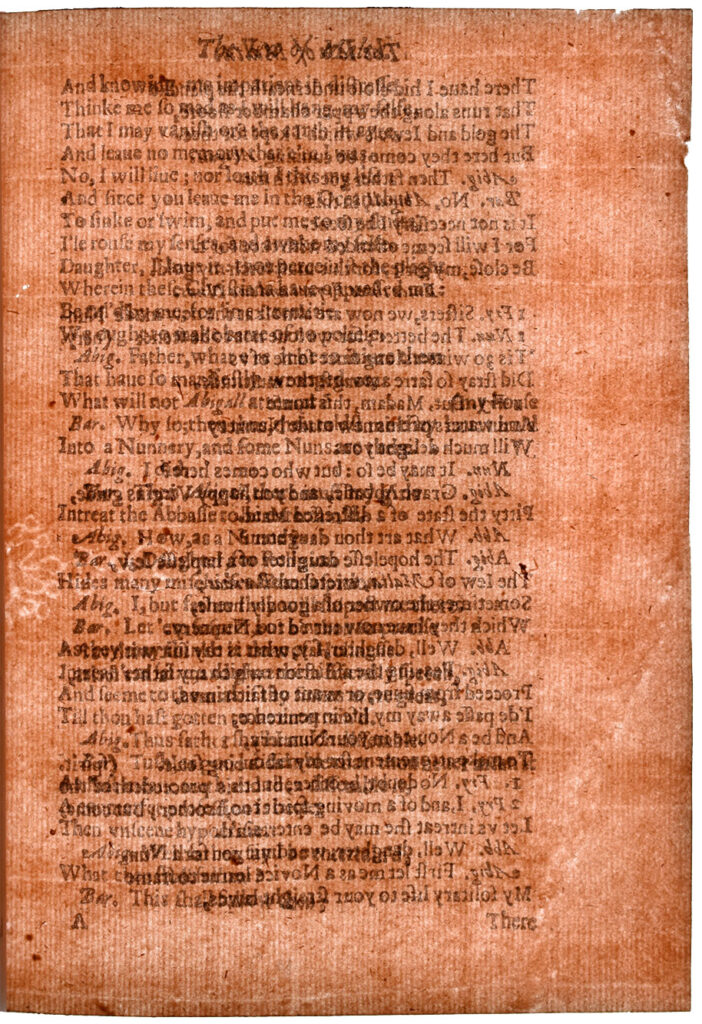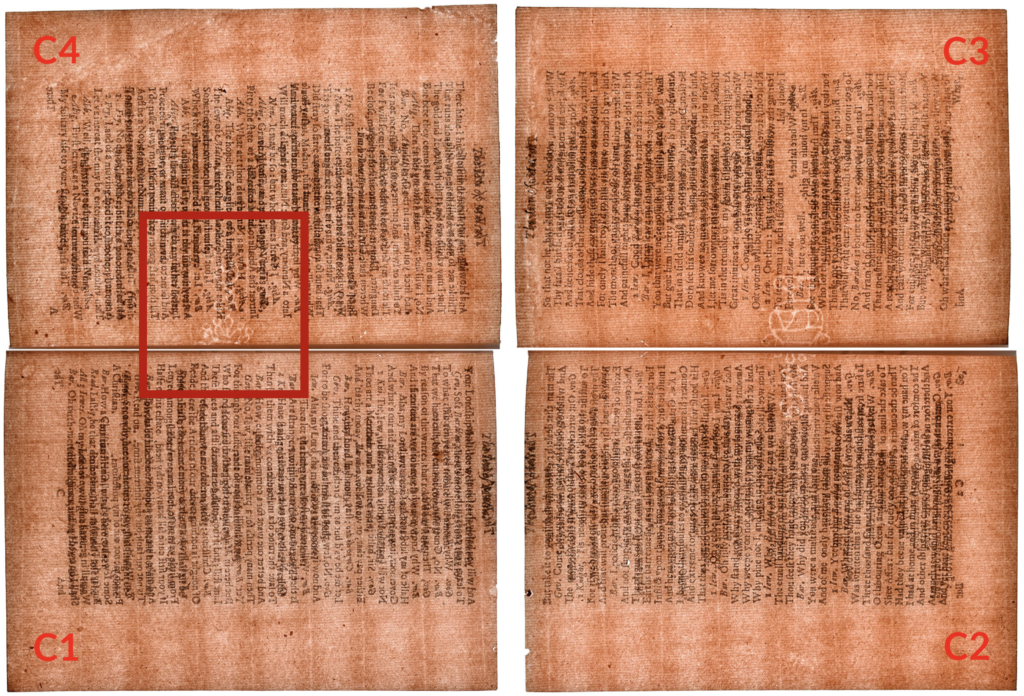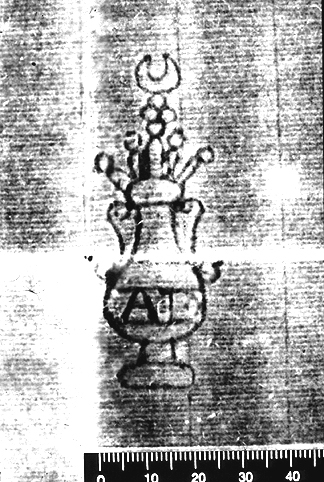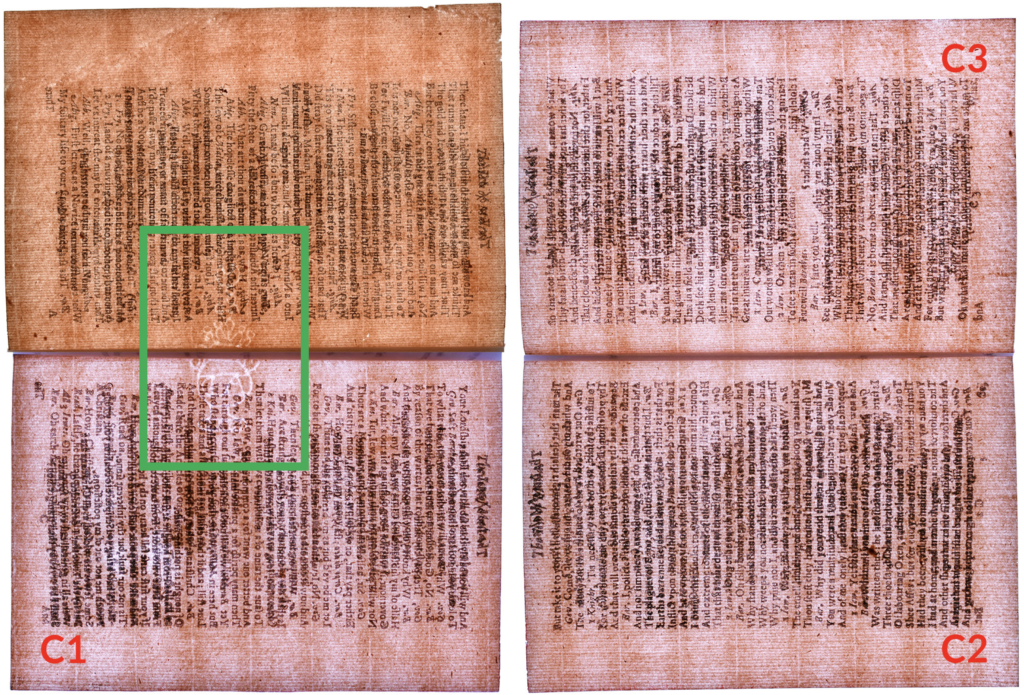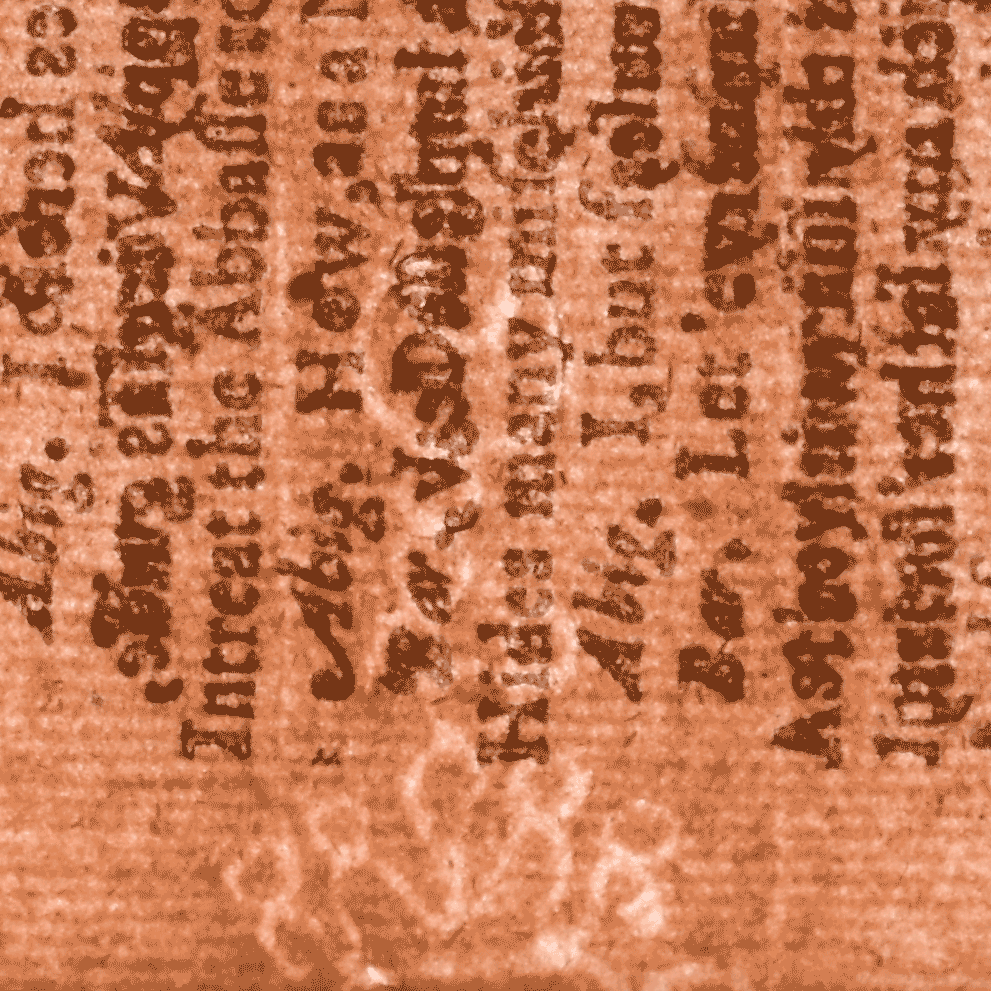The other day, I presented to a group of The Bibliographical Society of America‘s very generous donors about four copies of the earliest known quarto edition of Christopher Marlowe’s The Jew of Malta (London: Nicholas Vavasour, 1633). This post is to atone for I sin I made in the course of that talk: I showed a reconstruction of a printed sheet that I mistakenly included instead of another and that is straight up wrong. When I sat down to blast out the talk itself a month or so after doing most of the research for it, I’d somehow completely forgotten that I’d noticed my error at that earlier date, corrected my thinking with some additional analysis, and made some new images—ugh. On the plus side, the error presents an opportunity for me to think through some useful bibliographical methods with a broader audience.
I discussed the Malta copies I discussed because all four are associated with the bibliophile Thomas J. Wise. He’s most famous for forging a series of 19th-century pamphlets, but weird things also happened when he engaged with authentic early editions. Most shockingly, Wise—or conceivably an accomplice—stole a number of leaves out of early English playbooks in the British Museum’s (now British Library’s) collection for the purpose of filling gaps in copies that he (a) kept for himself, (b) sold to an American collector, John Henry Wrenn, and (c) worked with English collector, George Atherton Aitken, to build. In addition to stealing leaves to complete so-called “imperfect” books, he also moved existing leaves between copies, usually reserving what he considered the best example in the group for his own playbook and then using another for Wrenn’s. He supplied copies to and/or exchanged leaves with Aitken, too. The results were one copy with five missing leaves—the British Museum’s copy once owned by actor David Garrick—and three that are Frankensteins, with each pair of covers bringing together leaves from what were originally three different copies. Wild.
Bibliographer and then British Museum librarian, David Foxon, worked with Fannie Ratchford and then William Todd at The University of Texas to figure all of this out. Their painstaking analysis, which looked at different types of evidence—leaf measurements, repairs, impressions on adjacent leaves from paper imperfections, holes from previous pamphlet stitching, insect damage, edge coloring, and watermarks and chainlines—determined when leaves were out of place and identified them as having originated in one of four source copies, designated A, B, C, and D.
As part of my talk, I showed one of the stolen Garrick leaves as it now exists in Wrenn’s Wise-supplied Malta: the very final leaf of the edition. If you look very carefully and with the aid of a light sheet, you can see that there was a hole in it, right next to the “FINIS” at the very end. That hole was then almost seamlessly patched by Riviere and Son, the London-based bookbinding firm that Wise and Wrenn used, with another piece of compatible paper; the vertical wire lines mostly match up. The missing text on the recto was then supplied in pen facsimile:
But why on earth was there a hole in the middle of the page? Well, the British Museum liked to stamp title-pages and final pages with security stamps, ones designed to dissuade theft. On the right, below, is a bad image of the British Museum stamp that remains on the title-page verso of the Garrick Malta. My two images aren’t quite to scale, but the patched hole in the K2 leaf now in the Wrenn Malta almost certainly arose from a British Museum stamp being surgically excised to hide the leaf’s source. To hide the theft. (If you want to read more about the wizardry of binders like Riviere and Son, check out my essay in Collated & Perfect.)
Because both the Wrenn Malta and the Garrick have been digitized as part of IIIF-compatible online repositories, I was able to create a custom manifest that allows us to reassemble the Garrick copy for the first time in well over a century:
[Currently unavailable due to British Library outage]
Neat. OK, but as I mentioned, the three main copies of Malta that Wise handled—really, built—involved leaf substitutions beyond ones from the Garrick. Here’s my working table based primarily on the analysis undertaken by Foxon, Ratchford, and Todd:
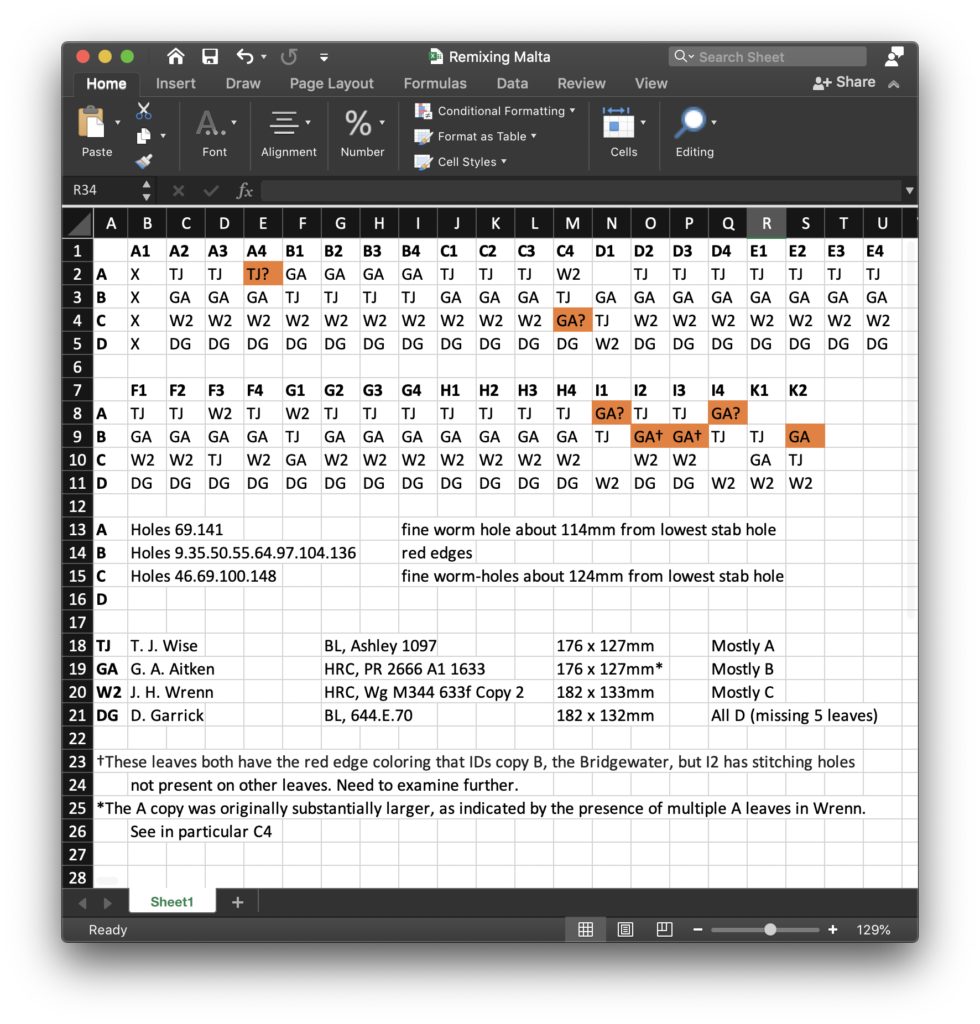
In two articles, Foxon (1959) and then Foxon and Todd (1961) produce individual charts for the Wise, second Wrenn, and Aitken copies as they now exist, recording which of the four original copies each of their leaves is from. Instead, because I’m interested largely in being able to reconstruct those original copies, I’ve created a single table that makes it easier to track the whereabouts of their leaves. My columns refer to each leaf in the edition—none of the copies has A1; the title-page is A2; the final leaf is K2—and the four rows refer to each of the original four Malta copies by the letters Foxon assigned them. I’ve then populated each cell with a two-letter label identifying the copy in which the leaf currently resides.
You’ll see that the leaves of copy D are all in the Garrick copy (DG) except for the five that were stolen and used in the Wrenn (WR). You’ll see, too, as I also indicate toward the bottom, that Wise’s own copy (TJ) is mostly made of leaves from the A copy; Aitken’s (AK) mostly from the B; and Wrenn’s mostly from the C. You’ll also notice a few completely blank cells: they appear only in columns representing leaves that were stolen out of the Garrick, as there were only three copies of those leaves to go around—or, at least, only three copies that Wise thought could be made to pass muster in his and his collector buddies’ copies. And then you’ll find orange cells with copy assignments that I’ve qualified with question marks. In the Foxon and Foxon and Todd articles, there’s a hand-toss when it comes to the seven leaves in orange: one now in Wise’s copy, A4, and then six that are now in the Aitken: C4, the four leaves of the I sheet, and then K2. The articles print simply that those leaves are “unassigned.”
I initially made my own assignments—tentative ones, hence the orange cells and the question marks—simply by process of elimination: if we don’t assume the existence of any copies not already in evidence, then there aren’t any other possibilities. Still, with both the Wrenn and Aitken copies not far from my office in the Ransom Center, I wanted to see if I could find evidence that Foxon et al. hadn’t noticed that could lock down the Aitken assignments. For the purposes of my BSA talk, I decided to focus on C4. Here it is in the second Wrenn copy, both sides:

It looks like a pretty clean, uniform, leaf, yeah? Well here it is with a light sheet behind it:
Check out those outer corners—the one at top-right, in particular, will become relevant shortly. What you’re looking at is more of Riviere and Son’s expert grafting. This time, though, you can see that, while the wire lines in both the base leaf and the repair pieces pretty well match, the chainlines do not. Here, it’s easier to see that we’re dealing with non-original paper that’s been added.
If you scroll back up to my table, you’ll see that Foxon assigned C4 in the Wrenn copy to what was once copy A and that the three other C leaves in Wrenn belonged to copy C. There are a number of pieces of evidence that led Foxon to these conclusions, but in this instance we can tell there’s a basic problem in the Wrenn copy by assembling backlit photos of each C leaf into what they would have looked like if originally from a single, full sheet of paper:
If you’ve read your preferred introduction to bibliography that covers European papermaking practices, you’ll know that sheets typically have either a single watermark positioned in the middle of one side of the sheet or a watermark in that position plus a distinct countermark in the middle of the other side of the sheet. On the right side, here, all seems well: we have a very typical pot watermark that, when we account for trimming when binding, is in the middle of that side of the sheet, traversing what became the inner margins of leaves C2 and C3 when the sheet was folded.
So you can get a sense of just how much of the mark we lose in the gutter and to Riviere and Son’s trimming, here’s a two-handled pot watermark with “AD” across its belly that’s very similar to what we see in Malta. It’s from the Gravell Watermark Archive and has been dated to 1634, the year after our playbook edition:
Back to my sheet reconstruction: on the left side, we’ve got a problem. On C1, we don’t see anything peeking out from the inner margin, which is what we’d expect. (That said, always be careful when ruling out the presence of a mark: tight or cropped inner margins sometimes obscure or remove them, and sometimes marks just don’t appear perfectly in the middle of the sheet. Especially in a bound volume, it’s possible for more compact watermarks than this pot to appear in only one of the two leaves you’d expect.) But look at C4—we see the top of a pot again, the same top we see, flipped, on C2. The absence of a mark on C1 can’t tell us for sure that it once belonged with C2 and C3, but that extra flipped pot top can indeed rule out C4 as having originally belonged with any of the other leaves, C1–3.
When I made this reconstruction, I also made one of the Aitken copy’s C sheet, which Foxon and Todd said was similarly sophisticated: C1–3 from the base copy, B; C4 from somewhere else. Here it is:
With this, we can also say that there’s a problem with C4: it definitely is not from the same sheet as C1—this pot mark is pretty tall—and, because I’m reasonably sure that there was no unmarked paper used in the Malta edition, it is almost definitely not from the same sheet as C2 and C3, either.
And this is where I initially did something without looking back at my chart and at Foxon’s explanation of the evidence he used to assign Malta leaves to particular copies. I was mistakenly thinking that the Wrenn leaf was the unassigned wildcard, not the Aitken and, so, made the reconstruction that’s the featured image at the top. Well, the same image except for the fact that I felt I had a match. This is the version I showed in my talk:
Doesn’t it look, at least at first glance, like we have a nice match? The chainlines all traverse the inner margins of C1 and C4 pretty nicely while still keeping the pages’ headers in line, and the watermark stacks well: minus what’s lost in the gutters and to whatever inner-margin trimming Riviere and Son did, we appear to have a pot in the right position. As I realized upon further consideration, though, we’re looking at a mirage.
In his account of Wise’s copy, Foxon noticed that a number of leaves in it—A2–3, C3, G4, H3, and I3—have been “restored at the outer top corner.” In my backlit photos, we see such a restoration to the Wrenn C4, too, and Foxon’s assignment of that copy to A, the base copy of the Wise, appears to have been made in part because of it. Now we can make sense of the featured image at the top of this post:
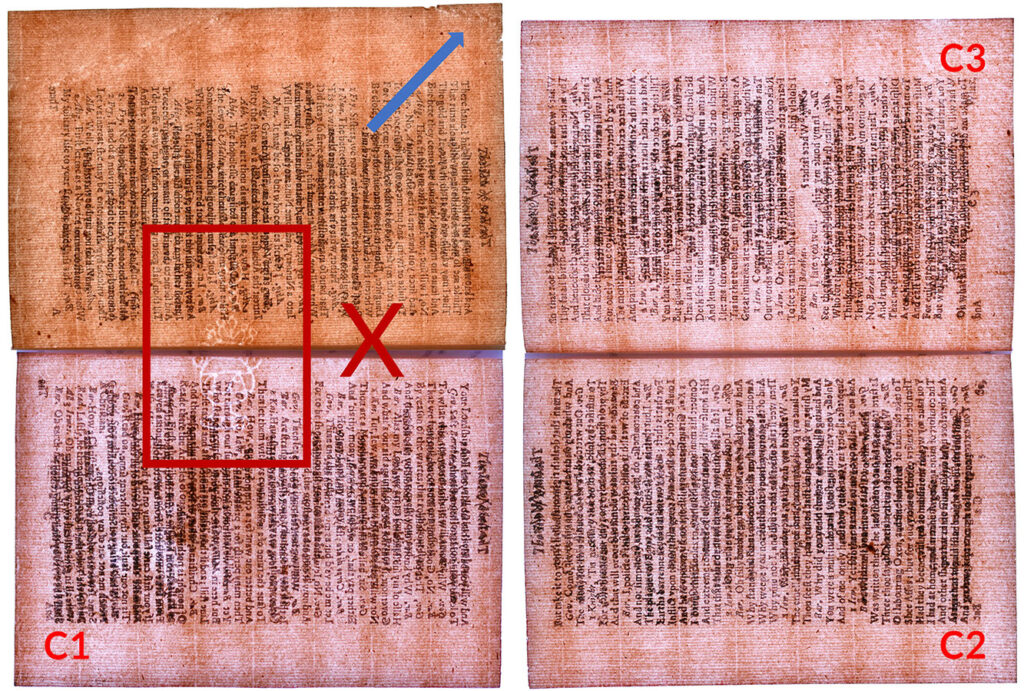
This example serves as a helpful reminder that sheets of paper made at the same time from the same mould are going to look very similar—essentially identical when it comes to wire lines, chainlines, and watermarks (at least until the wires used to form the watermark start to detach or otherwise shift around). For example, I am reasonably confident that the C sheets from the A and C copies were indeed made from the very same mould. Here, for one piece of evidence, is a GIF comparing the top of the watermark as visible in C4 in the Wrenn, from A, with the top of the watermark as visible in C2 of the Wrenn, from C. It would be very hard for marks from two different moulds to match this closely:
So, while sheets could go through the press in one of four orientations relative to the forme being printed, and while printers didn’t stick sheets onto the tympan in exactly the same position each time, there’s still a pretty decent chance of ending up with a false match when trying to reconstruct sheets—as in my mistake above. Caveat (digital) bibliographer.
The reconstruction I should have made based on my table is this one, which joins the copy of C4 in Aitken with C1–3 in the Wrenn:
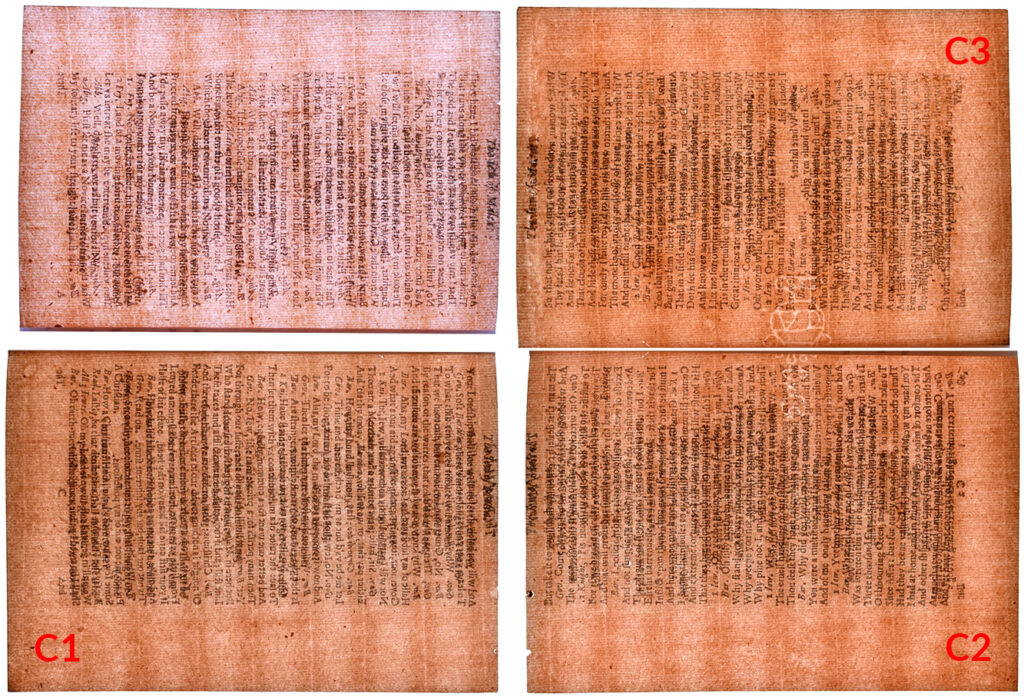
While this in all likelihood is the correct reconstruction, it probably doesn’t look as convincing as the one that’s wrong and can’t on its own give us a guarantee, for the reason I just mentioned. The most it really allows us to say is that C4 is compatible with C1–3. Well, that’s not entirely true: one incidental benefit of this image is that it helps us see that none of the individual leaves have much if any paper above the printed headers—or, in the case of C3, had before Riviere and Son got their hands on it. Wise apparently deemed that leaf’s cropping severe enough that he had it extended at the top:

After the new (to this copy) paper was grafted on, what were once acephalous letters were completed in pen facsimile. Check out the two pages of the leaf photographed with normal lighting in the Ransom Center’s cover-to-cover facsimile of the Wrenn copy. Then look at all of the leaves that are from copy C as designated by my table. If you keep an eye out for additional evidence of remargining at the tops of A2–3, G2, and H3–4, you’ll notice that heavy cropping of the top margin combined with otherwise healthy margins is a consistent feature of C leaves:
Importantly, too, it is not a consistent feature of the other base copies. You can compare with the A and B leaves in Wrenn as well as with those in the rest of Aitken:
All said, I think I can feel pretty confident about assigning C4 in the Aitken to copy C for three reasons:
- Process of elimination: we know where all of the other Malta C4s Wise is known to have handled ended up.
- Sheet reconstruction: the Aitken C4’s lack of a mark and particular chainline spacing make it possible that it was once part of the same sheet as C1–3 in Wrenn, which are C leaves.
- Upper-margin trimming: the Aitken C4 has nearly zero space above headers, which connects it with C leaves and not A or B leaves. (C4 in the Garrick, the source of D leaves, remains undisturbed.)
I suspect that, with additional analysis, I could strengthen the case even further. In any case, here’s what we get after all that work—a new chart with one orange cell now turned green, the question mark removed:

Bibliography, man.

